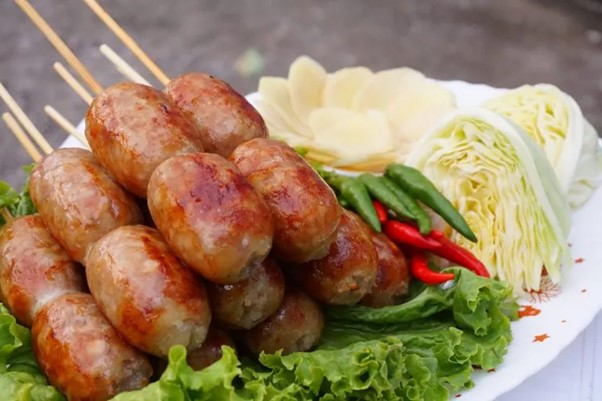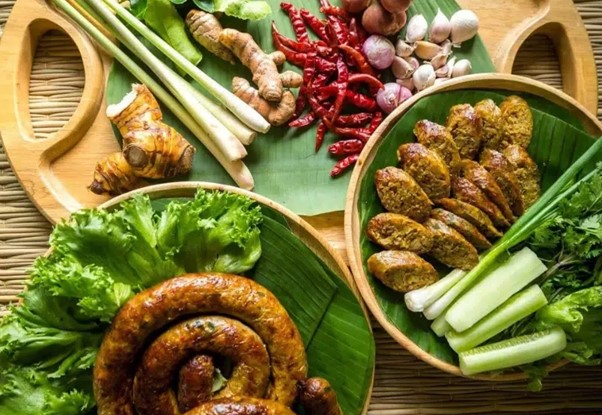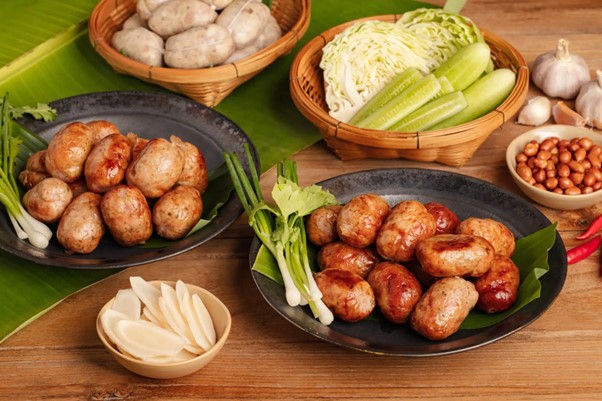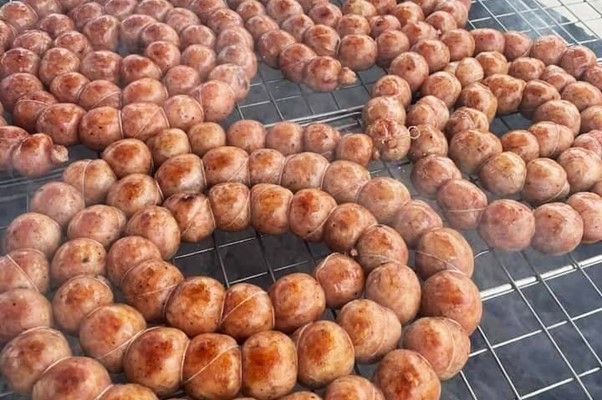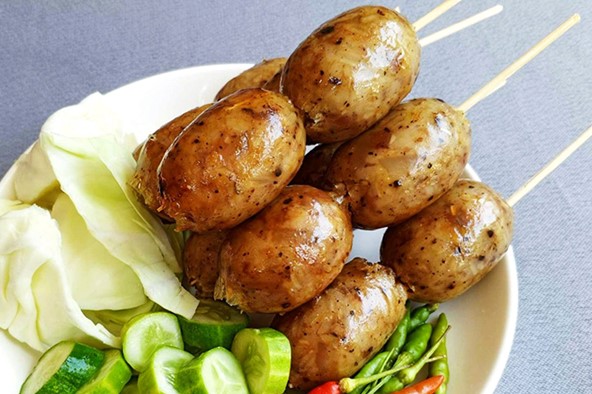When thinking of sausages, what do you think of? Is it bratwursts from Germany, chorizo from Spain and Portugal, salami from Italy or the sweet lap cheong from China? People don’t usually associate sausages with Thai food but they are actually a popular snack found on street carts and markets all over Thailand. Just like other regional foods, each area brings their own version of the sausage – all unique in style, flavour and ingredients. Let’s travel around Thailand and discover some of these sausages!
Thai sausages are often served with fresh chillies and vegetables (Image source | Localise Asia)
Sai Oua
Starting from the North, just like khao soi, sai oua is another Northern favourite for people all over Thailand. In Thai, the word ‘sai’ means intestine and in the Northern dialect, ‘oua’ means to stuff – together sai oua literally translates to stuffed intestine. This golden aromatic sausage is packed full of local herbs and ingredients, giving it a unique taste that has won over the heart of my husband (it’s his sausage of choice in Thailand!).
Sai oua and some of the ingredients that go into making them (Image source | Sute Ahan)
Traditionally sai oua is made with pig’s intestine and minced pork. Dried chillies, sliced galangal, lemongrass, shallots, garlic, shrimp paste and salt are pounded in a mortar and pestle to make a paste which is then mixed through the mince. Finely chopped fresh herbs are then added to complete the flavour, these include coriander, kaffir lime leaves and spring onions. When eating sai oua you will see all these colourful bits and pieces throughout.
Usually sai oua comes in a long curled up form, grilled over charcoal to make it extra fragrant. They are often sold by weight at market stalls and sliced into bite-sized pieces with fresh crunchy veggies accompanying them. In Bangkok I have also seen many stalls selling mini versions of sai oua which makes them very snackable! Apart from Thailand, sai oua is also found in Laos with slightly different recipes.
Sai Krok Isaan & Mum
Moving East to the North Eastern region or Isaan, the flavour profile of the region’s sausages differ greatly from sai oua. In Thai, sausages are called ‘sai krok’ which means ‘intestine filled’ so sai krok Isaan literally translates to Isaan sausages. These sausages are unique in its sour and salty taste – flavours that are developed from the need to preserve leftover hunted meat in the past.
Sai krok Isaan served with its accompaniments (Image source | Baan Somtum)
Sai krok Isaan is usually made with fatty minced pork mixed with a pounded paste consisting of coriander roots, pepper and garlic. Once massaged thoroughly, cooked rice is added and the mixture is seasoned with salt (traditionally from local rock salt ponds). When filling the mixture into the casing, people often tie them off into little sections leaving them in a long string. This makes the next step of hanging them up to air dry, ferment and develop the sour taste for 1-2 days easier. Once dried, they are then grilled and served with fresh cabbage, ginger, chilli and peanuts, a tasty combination that keeps you coming back for more!
A darker sausage called mum is also found in this region, however lean meat, blood, offals, roasted rice and garlic are the main ingredients. They are also air dried for a longer period from 3-7 days and can be eaten raw or cooked.
A string of sai krok Isaan on the grill (Image source | Benyapha TaTar)
Sai Krok Khao
Travelling down to the Central regions, sai krok khao or rice sausages are an old recipe that is unfortunately now quite hard to find. As the name suggests, rice is the star of the show. The mixture in sai krok khao is predominantly rice with a bit of minced pork, pork skin, garlic, pepper, coriander root and seeds and seasoning. This may look very similar to sai krok isaan however they are not sour from the fermentation process and are a lot more peppery.
Now that you know a little bit more about the different types of Thai sausages, I hope you’ll give them a try when you see them in menus or on the streets of Thailand!
Sai krok khao – if you look carefully you’ll see the grains of rice underneath the casing!
(Image source | Ananya Amy)
Article By Oun V.


